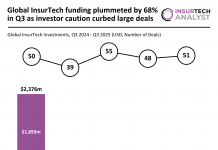How unlocking data can support the growth of reinsurance
Improving the access to data will not only help improve reinsurance but help the industry grow in new verticals, according to a panel at the Global InsurTech Summit 2019.
The panel at the Global InsurTech Summit, which included senior staff from Draper Esprit, AXIS Re, AON and JLT Specialty discussed the current challenges facing the reinsurance space and how firms are overcoming them.
Both reinsurance and insurance have been rather slow to adopt new technology, but the industry is shifting up a gear. There has been a total of $8.5bn deployed into the InsurTech sector since 2014, spread across 599 deals, data from FinTech Global shows. Of this investment volume, $3.1bn was invested in last year alone and was nearly double the $1.6bn which was invested during 2017. One of the biggest challenges facing the reinsurance space, according to Emma Karhan, head of public-private enterprise and reinsurer management, Reinsurance Solutions at AON, are around growth, costs and efficiency. The issue is the market is moving from a tangible market to a more immaterial one, which makes it harder to assess and insure these new risks.
Data has become the main talking point across the entire financial market, with it seen as the best way to improve customer satisfaction and business operations. The world has never been so connected, and with it, more data is being generated in ways it never was before. Online services and a magnitude of IoT devices are supplying new information around how consumers are interacting with items, their general online behaviours, or even how often they go for a run and stop to buy a drink. All of this information can be stored and, if consent is given, leveraged to offer more personalised services. Re/insurance is one of the main industries which can capitalise in a host of new ways.
Benedikt Schmid, chief information officer at AXIS Re said, “Reinsurance always has been an industry around data, and I think with these new technologies, there is definitely a huge opportunity in leveraging data more, combining data, get external data, leverage your internal data better. So that’s where we actually focus the most. In terms of building on your growth, by sort of having solutions maybe that require less touch, more automation, getting the efficiency play, that’s the small innovation.”
Automation of manual processes will help to give employees more time to focus on more important tasks, but also make it easier to traverse masses of data in order to identify the relevant potential risks. Schmid said that Axis Re has witnessed a protection gap with new areas that it hasn’t been able to reinsure, just because transaction costs would be too high. If a piece of technology could be implemented which boasts parametric products or fully automated products, it would enable the reinsurer to fill the gap. If this is then deployed widely, the reinsurance industry would be able to improve its growth.
Emma Karhan said that a part of this protection gap has been driven from how hard it can be to assess these new areas due to the lack of data around the risks. Obviously, when is something new there is very little data available to quantify and measure risks before you can underwrite and develop new products.
She added, “what we’re finding is that when you look at how you quantify and measure the risk of something that hasn’t been measured before, it’s a real struggle to get the data. And so, the more data you can find before you start approaching insurers and the industry, the better chance there is of it actually taking hold because the entrepreneurial spirit of an underwriter has disappeared in this day of the stock market and regulation. They won’t write a product until they have the data. But, often you can’t get the data until you write the product and so, you get into this chicken and egg thing.”
The easiest way to improve access to data is by building relationships and partnerships with the primary carriers. Both the insurer and reinsurer are aggregating data, and if a reinsurer can give the carrier added insights to create value it will build trust and encourage them to share more data with the reinsurer, Schmid said. This is a great way to build up an alternative data source. However, the ease of sharing data was not shared by Boris Corovic.
Boris Corovic, InsurTech research and development at JLT Specialty said, “I think there’s a similar bottle neck between data sharing from the end insured to carrier and carrier to reinsurer. That bottle neck is an end insured doesn’t want IOT technology in their company because they’re concerned about rates rising if the carrier knows more about their program then they would have known before. It would be the same stoppage on carriers sharing their information with reinsurers because they’re concerned about increases in rates.
“I have a theory about why TransRe partnered up with Concirrus to use their marine analytics satellite AIS solution and that’s because they’re trying to circumnavigate the disconnects between information sharing between the carrier and reinsurer by going out into the marine market itself and looking at trends there rather than looking at their own portfolio.”
Building up a base of data is going to be tough for any business, especially companies which have legacy systems. But InsurTechs are able to come in and help reinsurance firms improve their access to data and ensure they have what they need to underwrite, but also compare how they operate with industry standards or their competitors.
Karhan added, “That’s where there’s a real role for InsurTech, to start to building those databases and to build that non-specific or aggregated knowledge that perhaps we, as an industry can’t do, because that’s just not our wheelhouse. Assessing the vulnerabilities around IOT devices, or IOT systems is hard as we can barely understand what they are, let alone collect data on them.”
What’s the deal with blockchain?
Blockchain is very much like Marmite, with people either loving it or hating it. The last couple of years has seen talk of the technology skyrocket, but in 2019, things seem to be getting a little stale and it’s not longer on the tip of everyone’s tongues. An audience member at the Global InsurTech Summit, clearly had noticed and asked the panel for their thoughts on this notorious technology.
Schmid said, “Blockchain is cooling off and we’re on the downturn off the hype cycle as a whole. We haven’t seen much productive adoption beyond the cryptocurrencies. It will take time and I think if you listened to the analyst a couple of years back, they said it will require time and that’s exactly what’s happening. So, the inflated expectations that we’ve seen two years ago, I think it’s now more, maybe a bit too pessimistic at the moment. I still think that the technology has its merits and could be a game changer for certain use cases, but it will require more time, both on the technology maturity and also if it requires industry collaboration, that’s always been hard, irrespective of the technology.”
Boris Corovic also agreed that blockchain had sort of run its course for now and was not at the top of the priority list as it once had been. A reason for the setback is that it is still open to the same vulnerabilities as traditional IT systems are, such as, if a criminal gains access to a password they can still breach the ledger.
Karhan said, “We are a slow-moving big ship, and nothing happens in this industry quickly. And I think something like blockchain also is going to change things so fundamentally ultimately that everyone is terrified. No one knows what to do with it really.”
Copyright © 2019 FinTech Global
Investors
The following investor(s) were tagged in this article.










